The Top 10 Teen TV Shows Of All Time
Degrassi doesn't even make the cut.

The tropes of teen television are so familiar that they’d make a very reliable drinking game. You’ve got the misunderstood outsider (check), the catastrophic school dance (check), the side-eye glances in the corridor (check) and the forbidden love triangles that always end in disaster (check check check).
This makes it seem like teen television is a tired and predictable genre, but it’s not. The reason why people fondly remember the TV from their youth is because it can offer a sparkly escapism from your boring, less-than-glamorous adolescence. Sometimes certain shows seem indistinguishable from your own teenage Salad Days. The best ones endure because they’re the perfect cocktail for great melodrama. I mean, it shouldn’t be a surprise that stories about people making adult decisions without the wisdom of adulthood is captivating viewing. (Also: great clothes.)
For your reading pleasure/extreme displeasure, here is a list of the top ten teen TV shows, ranked according to how they contribute to the teen TV canon.
–
10. Beverly Hills: 90210 (1990-2000)
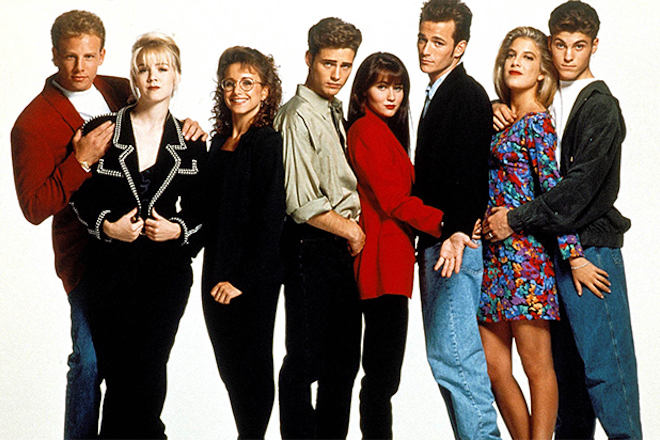
Premise: Twins Brenda and Brandon move from Minnesota to California (cut to a lot of scenes of them saying, “Woah! We are a long way from Minnesota!”) where they attend the glamorous West Beverly Hills High School. There, they meet the spoiled Kelly, jock Steve, bad boy Dylan, nerdy Andrea and a bunch of other people who are of no real consequence (sorry, Donna). Throughout the show’s very, very long run, the gang mixed and matched romantic pairings multiple times and each took turns having a raging drug habit. Aside from Degrassi, 90210 was one of the first teen dramas actually made with a teen audience in mind (but no one looked like an actual teenager).
MVP: Brenda Walsh. 90210 was all based on the outsider gaining access to a fast-paced, glittering life that they never felt quite comfortable in (this is true of almost all the shows on this list) and while Brandon Walsh was like a deer in headlights until the bitter end of the show, Brenda wholeheartedly embraced her new life, and provided most of the drama. And again: cool clothes.
Teen TV canon moment: 90210 was very big on end-of-the-episode moral lessons, which was very typical for early ’90s TV aimed at young people. You can see its influence in teen shows that have come since (especially the ‘will they or won’t they?’ set-up of Brenda and Dylan sleeping together on prom night) but the go-to moment has to be when Brenda finds out that her best friend Kelly and boyfriend Dylan had a fling while she was in Paris. Brutal.
–
9. Gossip Girl (2007-2012)
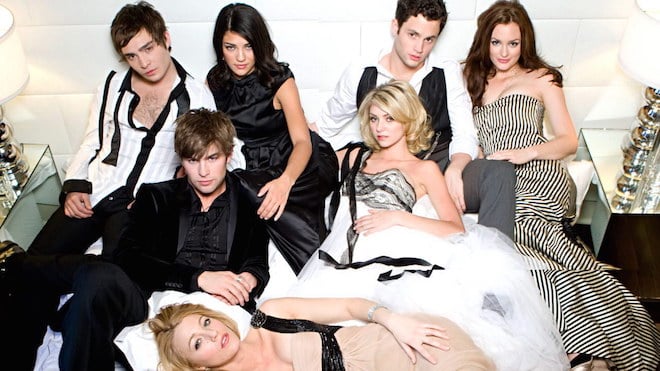
Premise: Gossip Girl is an anonymous blogger who spills the secrets of an elite group of It Kids who go to private schools in New York’s Upper East Side. This includes Serena van der Woodsen, Blair Waldorf, Chuck Bass, Nate Archibald and the poor ‘outsider’ kids: Dan and Jenny Humphrey. They all fall in love, become embroiled in sex scandals and have very lavish parties. Gossip Girl was probably the first teen TV show to properly deal with the advent of social media and the impact this has in dictating young people’s lives (it also kind of glamourised cyberbullying, but that’s a different story).
MVP: Blair Waldorf. Blair was the culmination of every Melrose Place-esque vengeful, bitchy character, but she was also completely driven my ambition and academic excellence. She was often jealous of her pal Serena (just like the audience) who never really had to work that hard for anything. She wore a lot of headbands and had some great one-liners.
Teen TV canon moment: Gossip Girl was well known for its outrageous “omg” moments, in fact its marketing campaign was entirely based around them. The love triangles (Chuck/Blair/Nate, Nate/Blair/Serena, Nate/Serena/Dan, Dan/Serena/Vanessa) were always saucy, but the conclusion of the first season made it clear that this wasn’t your mumma’s favourite teen TV show. The conflict? Oh, just the fact that Serena killed someone and was being blackmailed for it.
–
8. Buffy The Vampire Slayer (1997-2003)

Premise: Buffy Summers moves to Sunnydale after being expelled from her last high school on account of burning down the gym. This is because secretly Buffy is a slayer; the “Chosen One” who has the ability to fight demons and other forces of darkness. Buffy and her classmates Willow, Xander, Cordelia (sometimes) and Oz fight various baddies with the guidance of her Watcher/the school librarian, Giles. Sunnydale High is built on the Hellmouth, so for these teens, high school is very literally hell on earth.
MVP: Willow Rosenberg. Willow begins as Buffy’s nerdy best friend, who pines for Xander and doesn’t seem to get a lot of attention. However as the show progresses, she emerges from the sidelines to play out the power fantasy of the teen witch and is afforded supernatural autonomy. After high school she begins a relationship with fellow Wiccan Tara, one of the first lesbian relationships ever depicted on American TV.
Teen TV canon moment: Although Buffy‘s supernatural element makes it hard to place genre-wise, it embraced teen TV tropes wholeheartedly and provided not-so-subtle demonic metaphors for adolescence (at Buffy’s graduation, the students literally blow up the school to destroy the mayor who has turned into a snake monster). But the canon moment has to be Buffy deciding to sleep with her vampire boyfriend Angel, which results in him losing his soul and turning evil (a plot point that kind of works even without Angel being an 18th century vampire).
–
7. Gilmore Girls (2000-2007)

Premise: Although the show only spends three seasons in high school, adolescence is a huge theme in Gilmore Girls — particularly as Lorelai Gilmore’s teenage pregnancy is the defining event for everything that happens in the series. Rory lives in a small town, Stars Hollow, and attends an elite prep school called Chilton where she has to deal with academic rivals like Paris and borderline sexual harassers like Tristan. Rory was kind of a trailblazing character in teen TV: she cared deeply about school, wasn’t interested in socialising (not in a Daria way, she just had her best friend Lane in Stars Hollow and didn’t need anyone else) and gave hope to girls who were likewise content reading a depressing Russian book and listening to The Shins on their lunch break.
MVP: Lane Kim. Despite being a bit of a music snob (or because of it?) Lane is the MVP because she seems to transcend the one-dimensional ‘best friend’ caricature. She’s much cooler than Rory, calls her up on her shit and has some pretty exciting romantic storylines all on her own (helloooo, Seth Cohen!). Plus Lane was a drummer AND a cheerleader, defying the social cliches traditional in much of teen media.
Teen TV canon moment: While Rory and Paris’ continued power struggle at Chilton provided some nice relief from boys being the only point of tension among female characters on teen TV, the most schmaltzy moment had to be when Rory’s long-term boyfriend Dean broke up with her at the Stars Hollow 24-Hour Dance Marathon. This set into motion her torrid relationship with bad boy Jess (who was the best of her boyfriends in the series, fight me).
–
6. Skins (2007-2013)

Premise: A gritty teen drama that took a less sanitised look at drugs, sex, religion, mental illness and dysfunctional relationships, Skins was also remarkable for refreshing its cast three times (the first two generations were better than the last, but that’s still pretty good odds). Plus, these kids were actually teenagers! The first cast was led by arrogant Tony, his burn-out best friend Sid and Tony’s on-again-off-again girlfriend Michelle. The excessive drinking and drug-taking on the show apparently inspired “Skins parties” in England, which sound both exciting and disgusting.
MVP: Sid Jenkins. Even though Sid was a bit gross and never took off his beanie (was he kind of cute? Kind of?) his underdog story was the most relatable because he never really ‘won’; which is probably as realistic as it gets on teen TV. He always wanted girls who weren’t interested in him, was rarely interested in the ones who gave him attention, and had to deal with people comparing him unfavourably to Tony all the time. But, even now, he’s probably still the most popular character from the show.
Teen TV canon moment: When Sid gets together with Michelle, who he has been in love with for the whole series, and gets caught by his recently-dumped girlfriend Cassie, who has just returned from Scotland to make up with him. Cassie then tells everyone, including Sid’s best friend and Michelle’s ex-boyfriend, Tony. Phew!
–
5. Dawson’s Creek (1998-2003)
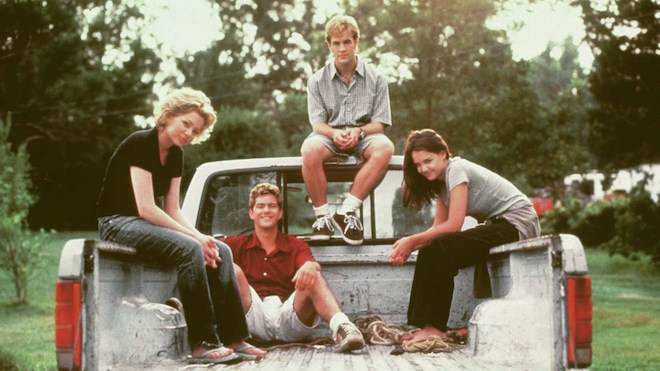
Premise: Dawson is a fairly self-absorbed teenager who makes home movies and sits around talking about his feelings with his wise-cracking best friend Pacey, his childhood pal/soul mate Joey and his worldly once-girlfriend Jen. This show was pivotal not only because it was a pop culture phenomenon (Joshua Jackson and Katie Holmes in particular dominated teen films in the late ’90s) but because it didn’t trivialise teenagers or their problems. It was also one of the first teen TV shows with a successful tie-in soundtrack.
MVP: Pacey Witter. He was the most quotable character on a show full of very verbose speeches and was pretty much the only one who you would want to hang out with IRL. Through his relationship with Joey, Pacey became one of the most popular teen TV crushes of the decade.
Teen TV canon moment: Although it kind of happened by accident, the pairing of Joey and Pacey revived the show and continued to have ramifications until its very last episode. Joey being pulled between between Pacey and Dawson remains one of the best teen TV love triangles of all time.
–
4. My So-Called Life (1994-1995)

Premise: Angela Chase is a melancholy 15-year-old who is struggling to forge a new identity. She becomes friends with rebel girl Rayanne Graff and her sidekick Rickie Vasquez, who expose her to a different and more rebellious scene. Angela’s old friends Sharon and Brian hate this change in her but she doesn’t care because all she can think about is kissing Jordan Catalano (like, same). My So-Called Life wasn’t ashamed of its own relentless emo-ness which is key, because it means that it wasn’t too embarrassed to let its characters wallow (flopping on a bed and listen to The Cranberries really loud, contemplating killing their own mother at the dinner table, et al.). This may seem trite to grown-ups, but to moody teenagers it’s more relatable than anything that ever happened on Saved By The Bell.
MVP: Rayanne Graff. Rayanne was the wild and cool girl that everyone wants to be in high school; she’s fearless but also generous and this is the basis of her and Angela’s obsessive friendship. There aren’t many TV shows that are able to capture the intensity of these kinds of teen relationships, but My So-Called Life depicted this platonic romance perfectly.
Teen TV canon moment: My So-Called Life only ran for one season, but there literally isn’t a bad episode in the bunch. One of the most heartbreaking and poignant moments came in the ‘Life of Brian’ episode, in which Rickie thinks that a boy named Cory had been flirting with him, only to find out that he really wanted Rayanne. Brian, who is perpetually in love with an unaware Angela, breaks a date with Delia in the hopes that Angela will ask him to the dance. Everyone is alone and miserable, and then Rickie asks Delia to dance, ARGH, MY HEART.
–
3. Freaks and Geeks (1999-2000)

Premise: Another show that was gone too soon (or just soon enough to make it iconic?) Freaks and Geeks was the brainchild of Judd Apatow and Paul Feig and was responsible for launching the careers of Seth Rogen, James Franco, Jason Segel, Martin Starr, Linda Cardellini and John Francis Daley. At the time it was under-appreciated enough that it was cancelled, but now it’s seen as one of the greatest TV shows of all time. At a time when Dawson’s Creek was still the most popular teen show on TV, Freaks and Geeks took a less glamorous look at adolescence focusing on the humiliation and injustice inherent to life in high school. None of the characters (even the rebellious ‘freaks’) felt comfortable in their own skin, and that was the point.
MVP: Sam Weir. Sam is almost a cartoon character of an early high school student; constantly gobsmacked and alarmed by everything around him, resentful of his classmates who have a head start on puberty and desperately, hopelessly wishing to someday be cool. Sam’s high school experience is almost too real.
Teen TV canon moment: Fearful that his sister Lindsay might die from alcohol poisoning, Sam switches the keg at her party to one of non-alcoholic beer (note: Sam is too earnest to play tricks on anyone, he genuinely thinks that she might die). All the teenagers think they are drunk anyway and start crying/feeling each other up. The best inversion of the teen movie party scene ever.
–
2. Friday Night Lights (2006-2011)
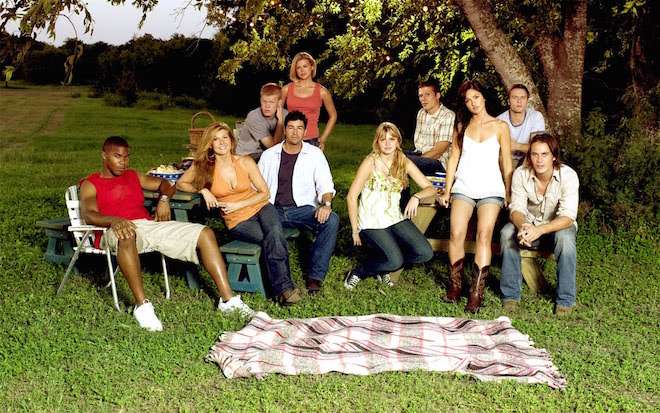
Premise: Eric Taylor has just started coaching the Dillon Panthers — one of the most successful high school football teams in Texas. After tragedy strikes, Coach Taylor has to figure out how to rebuild the team (which is made up of clashing personalities like brooding/drunk Tim Riggins, loudmouth Smash Williams and constantly petrified Matt Saracen) and deal with the expectations of the football-crazy small town. One of the remarkable things about Friday Night Lights was that it didn’t suffer from the dreaded ‘college curse’ like other shows. When the first lot of high school kids graduated, they just moved on to a new crop of teenagers who were just as good as the first. It helped that the second cast was led by a baby-faced Michael B. Jordan.
MVP: Tami Taylor. The ultimate teen TV mum, Tami was the kind of character who makes you care about the parent’s storyline as much as the kids. She is the only one who can put Coach Taylor in his place and seeing her try to care for her often bratty daughter, Julie, is kind of heartbreaking. She will make you feel bad for the way you talk to your mum.
Teen TV canon moment: Even though Friday Night Lights was definitely a teen show, it didn’t look like it. One of the reasons it’s still considered prestige television is because each episode looked and felt like a mini-movie. Its focus on the parents and the minutia of small town life was great, but it was the reluctant quarterback Matt Saracen who was the real heart of the show. Matt’s dad was in Iraq which made him the sole custody of his dementia-affected grandmother. Coupled with the pressure of the team, Matt was a ticking time bomb of anxiety ready to explode. After Julie Taylor dumps him and Coach Taylor leaves the team, Matt finally starts to show the cracks.
–
1. The O.C. (2003-2007)
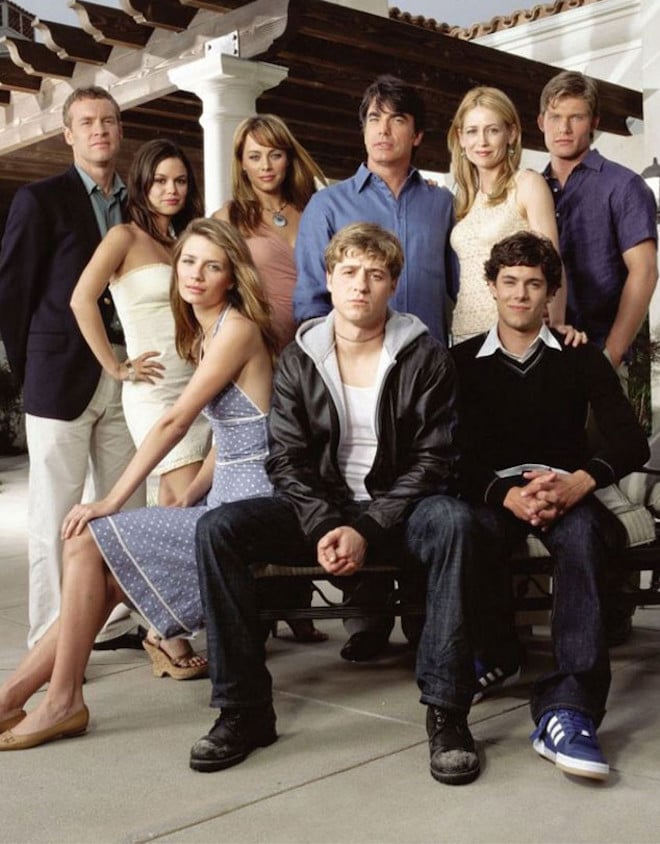
Premise: It seems almost redundant to explain what this show is about, because y’all know. For the kids: Ryan is a poor kid from the rough neighbourhood of Chino who somehow ends up living with the wealthy Cohen family in Orange County. There, he makes friends with emo-geek Seth, falls in love with the troubled It Girl Marissa, gets beat up by her jock boyfriend Luke, and doesn’t really have much to do with ditzy Summer.
The first season of The O.C. was some of the most exciting teen television ever written (shout out, Josh Schwartz!). It was funny (like, properly funny) and its characters made the same pop culture references that real teenagers made and actually listened to music that real teenagers listened to (except Rooney, obviously). It was self aware, but still knew that glamorous escapism is one of the best things about the genre. The O.C.‘s first season crammed so much melodrama into its 27 (!!) episodes, that the rest of the series was never as good in comparison. However it continued to be sharp, quotable (“Yogalates!”) and warm until the end, capturing the mid-200os zeitgeist in the most perfect way — with a cameo from Paris Hilton to boot. It also took the piss out of itself constantly (The Valley, anyone?). It was the smart, quippy show that teenagers had been waiting for.
MVP: Seth Cohen. This character became so ubiquitous that you may remember him as more annoying than he actually was (unless you had a crush on him, then you probably remember him very fondly). Seth was kind of a rarity on TV back then: the funny, awkward loner kid who really thought he was cooler than everybody, but didn’t have any actual friends to confirm that fact. Really, he was a skateboarding dreamboat (who had some entitlement issues, but we won’t get into that now). This character came at a perfect time (did he kickstart the commercialisation of the hipster?) and to be honest, hearing someone identify as an emo on TV was about as relevant as TV got in 2003.
Teen TV canon moment: It may not be as critically acclaimed as some of the shows on this list, but for anyone who was a teenager in the 2000s, The O.C. is iconic. It took every teen TV trope (the outsider, the beauty queen, the quirky offsider), looked at it under a magnifying glass and then turned it on its head. What if the rebellious outsider turned out to be the smartest kid in school? What if the beauty queen was a disastrous alcoholic? What if the nerdy best friend was in a love triangle with two of the most beautiful and coolest girls in the school? One of the earliest moments, Ryan saving Marissa from a drug overdose in Tijuana, set the tone for the rest of the series and for every teen TV show that has come since.
–

